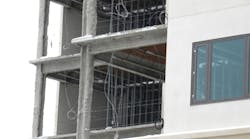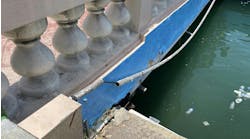How well do you know the Code? Think you can spot violations the original installer either ignored or couldn't identify? Here's your chance to moonlight as an electrical inspector and second-guess someone else's work from the safety of your living room or office. Brian, who has a knack for finding shoddy electrical work, did the dirty work and found this mess. Now it's your turn to identify the violation.
Find the Answer
This photo appears to show a violation of the requirements set forth in 110.11, which says, "Equipment not identified for outdoor use and equipment identified only for indoor use, such as 'dry locations,' 'indoor use only,' 'damp locations,' or enclosure Types 1, 2, 5, 12, 12K and/or 13, shall be protected against permanent damage from weather during building construction." The reason I say this appears to be a violation is it seems logical that if the cable sheath were to rust — as a result of exposure to the weather and outdoor elements — then this would constitute "permanent damage."
But what if the conductors oxidized during this exposure period? If they did, and you were able to remove the oxidation from the conductors, then one would assume such damage would not be considered "permanent." Therefore, there would not be a violation of this rule. But is such remedial action recognized as returning the conductors to their original condition, or does any such degradation mean the cable would have to be replaced?
The Code gives no guidance on this matter. However, while the NEC does not address the concerns stated here, the National Electrical Manufacturers' Association (NEMA) did publish a technical paper on water-damaged equipment and conductors back in 2006. The press release announcing the paper indicates that water-damage equipment and conductors pose a potential danger if reenergized without remediation of some sort. Additionally, it goes on to state where equipment or conductors are exposed to water, they may or may not be able to be reconditioned, but such determination should be made in consultation with the equipment manufacturer. This press release also admonishes electrical distributors from selling water-damaged equipment and conductors.
While the press release is useful, inasmuch as it alerts one to the potential for danger, the paper itself provides more detailed guidance on what should be done under different scenarios. It is a very useful document you should be familiar with. A copy of the paper can be downloaded free of charge.
Although the above referenced technical paper can provide extremely useful guidance when dealing with water damaged equipment and conductors, it seems the best way to deal with this matter is to prevent such exposure in the first place. In this situation, if the coils shown in the photo were stored in plastic garbage bags, or were secured to the overhead and protected from the elements, then there would be no need for concern.



